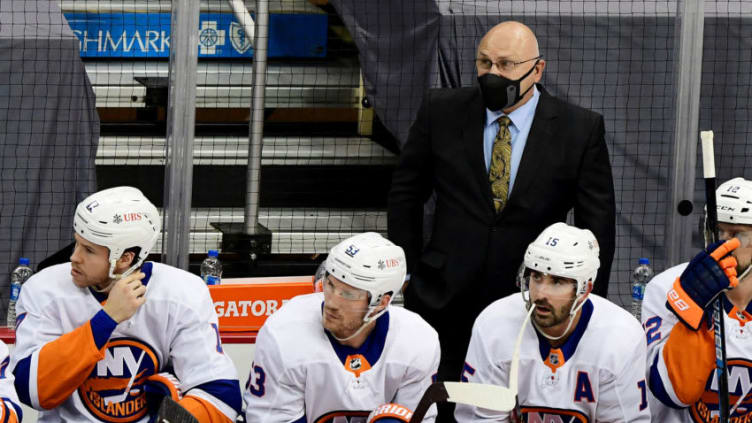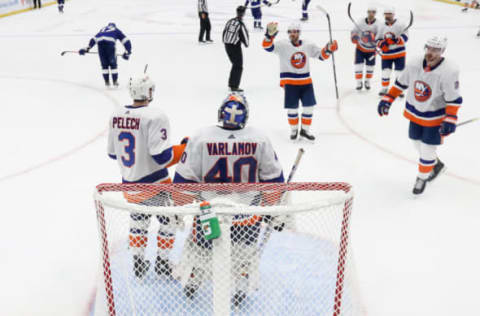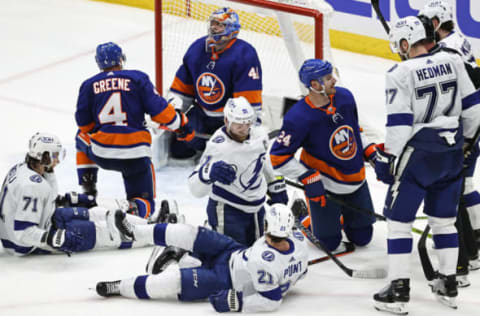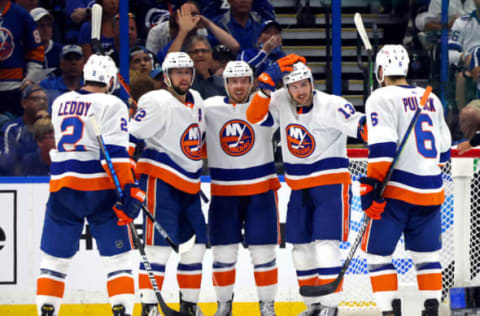Islanders: Three Takeaways from Game Three Loss to Lightning


The New York Islanders brought a pretty good effort to Nassau Coliseum on Thursday night, but fell 2-1 in a tight-checking game three.
The New York Islanders fell 2-1 to the Tampa Bay Lightning in game three of their Stanley Cup semi-final matchup. The Isles now trail Tampa two games to one in the best-of-seven series, but they played a fairly good game. One that would likely be enough to win most nights, against most teams.
Here are three takeaways from the game three defeat at the Coli.
1. Islanders Were Good Enough to Win
It isn’t always easy to focus on positives after a loss such as Thursday’s game three. There wasn’t a lot of time or space on the ice at the Coliseum as both teams stuck to their game plans well by clogging up lanes, maintaining gaps, and generally playing a tight-checking brand of playoff hockey. But the Islanders didn’t play as poorly as many fans seemed to think.
Considering the chatter online, it would be easy to think Tampa suffocated the Islanders all game and defeated them handily in all situations. That wasn’t really the reality of the game, though.
Yes, Tampa shut things down well in the third period. They limited the Isles to basically no scoring chances in the final five minutes of regulation, and after New York pulled goalie Semyon Varlamov the Bolts 5v6 defense was magisterial in clogging the neutral zone and defending their own blue line.
But the final numbers from game three show that the Islanders were every bit a deserving winner who fell short on Thursday. According to Natural Stat Trick, New York finished with greater than 58% of the scoring chances (SCF%), high-danger chances (HDCF%), and expected goal (xGF%) shares, when adjusted for score and venue.
That may be little consolation after back-to-back losses in which the team has posted just three goals. But the advanced numbers are showing that the Islanders were in game three, and they’re still in this series.
NST’s series report shows that through three games in this semi-final series, the Islanders hold the upper hand in Fenwick For percentage (FF%), HDCF%, and xGF%.
Those numbers are also adjusted for score and venue to compensate for any scorekeeper biases that may exist at the Coliseum or Amalie Arena.
While those numbers aren’t everything, and yes teams have lost series despite leading in all those categories (just look at the Penguins and Bruins series), it’s an indicator that this series is far closer than many of the gloomy forecasts floating about online.
It also says that the Islanders are more than likely not done in this series, despite once again falling behind two games to one.

2. Islanders Defended Their Slot Well in Game Three
Both Tampa Bay Lightning goals came from shots within 10 feet of the Islanders goal line in game three.
That said, it would be fair to say that overall the Islanders did a fairly good job of defending their own slot. According to MoneyPuck’s interactive scoring chances map, the Lightning only registered four unblocked shot attempts from the inner slot.
Meanwhile, in the offensive zone, I counted 11 New York shots from the inner slot on the MoneyPuck scoring chances map, though there could be more which I missed due to the Tampa net-front being a pretty solid blob of blue circles indicating chances for the Isles.
The Islanders ability to lock their net-front down and force teams to take lesser percentage shots from the outside is one of the team’s greatest strengths. Yet, in each of games one and two Tampa registered a large number of scoring chances from New York’s inner slot, so it’s not as if the Lightning are simply abandoning the slot to focus on shooting from the point in this series.
More of what it looks like to me is that New York simply defended their slot well.
The Gourde goal was the result of a bit of a broken play, which can happen to any team. Brayden Point’s game-winner came after an extended stretch of zone time for Tampa while on the power-play and was an extraordinary effort by Point to get the shot away.
Again, these are not indications that the Islanders will win game four. It isn’t an indication that they will win the series, or even win another game in the series. But they are indicators that the Isles are competing well against the Lightning, and there is certainly room to make the argument that a bit of puck luck could’ve drastically altered the result of game three.

3. Islanders need to find some Goals
After scoring just three goals in 120 minutes, it’s clear the New York Islanders are struggling to beat the Tampa defense and their goaltending ace Andrei Vasilevskiy. That isn’t a major surprise, either. Vasilevskiy is among the best goaltenders in the world, possibly the best, and the Lightning defense is formidable in its own right.
It’s also difficult to say the Islanders haven’t generated any offense, as I’ve previously given multiple numbers which dispute that stance. But despite the lopsided HDCF% share in their favor (14-5 NYI, at 5v5), the Islanders still are wanting for more goals after game three’s 2-1 loss.
Part of that will have to come from the Islanders doing a better job at making what chances they do create more dangerous. Vasilevskiy is an elite goaltender, and it just isn’t going to be easy to beat him when he has clear sightlines on the puck.
Ryan Pulock’s game one blast from the point simply overpowered the Russian goalie, but that isn’t something that can be consistently relied upon to create goals.
The Islanders need to take away Vasileskiy’s eyes, so to speak. Create chaos in the net-front, which they did a pretty good job of in game three. Shoot through multi-layered screens, and redirect pucks on their way toward the net.
That, obviously, is easier said than done. Tampa, for all the talk of their skill and elite puck movers, are also a team who buy-in and sell out to do whatever it takes to win, as was personified by Steven Stamkos blocking a shot late in game three.
The Lightning are good at getting in shooting lanes and taking away point shots. They also take away the middle very effectively in their own end and force opposing offenses to move toward the outside.
The other part of the Islanders finding more goals comes down to a bit of puck luck. New York’s 9.97% high-danger shooting percentage (HDSH%) is dwarfed by that of Tampa’s 20.44% throughout the first three games of this series.
Tampa’s high-danger save percentage (HDSV%) is .900 through three games, as opposed to the Islanders’ .796. At some point, one would figure that some regression to the mean is due. The Islanders are going to get bailed out a bit more, and Tampa will get bailed out a bit less to even those percentages out.